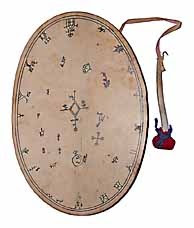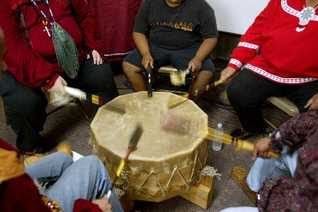The Invitation of the Sacred Drum
I had the marvelous experience of hearing the Soweto Gospel Choir in concert last night. I can’t imagine a more enlivening way to spend an evening, unless it might be to get up on stage to sing and dance with this amazing choir. In fact I was hard pressed to stay in my seat, as was Rev. Annemarie Richards, my friend and fellow hand-clapper, toe-tapper and head-bobber. Okay, by the end of the night we’d said to heck with the somewhat staid Princeton crowd and were on our feet, laughing our heads off while tears formed in our eyes.
In the beginning of the concert, as soon as the music started, the light still low, a solitary voice called out and then we heard the beat of the drum – those djembe drum that I remember so well from living in Paris, where people gather in every park to play them. I found my self starting to cry almost immediately. This happens to me every time I listen to gospel music. You should have seen me at the House of Blues Gospel Brunch a few years back. Oh, I was a mess all the way through the scrambled eggs!
What is it about this music? Well, I wonder if doesn’t begin with the beat of that drum? If there isn’t something deep inside us that’s reached when a drum, and dare I say a scared drum, like that is played. Perhaps it connects us to the music that exists all around us, the rhythm of life, if you will. There was a spectacular moment in last night’s performance, called “The Canteen”, when a group of the male performers sat at a table set with spoons, forks, plates and glasses. Within moments, someone started tapping out a rhythm on a glass, someone else joined in on a plate, another the counter rhythm, syncopation, singers joined in, and within seconds the everyday world was alive with joy, with music, with celebration. It was an invitation, loud and clear, to join to exuberant celebration of life. The sort of celebration that can’t be contained, but bursts out, explodes, in song and laughter and dance.
We North American white folks have lost our drum, and it’s a great pity, since it is the beat of the sacred drum which connects us to our own heartbeats, to the heartbeats of our fellow creatures and to the heartbeat of life itself. I have been privileged over the years to hear a number of sacred drummers — djembe drummers Inuit drummers, Objiway drummers, Bodhran drummers, Japanese Kodo drummers.
One drum I have always wanted to hear played live is the drum the Sami people (the indigenious people of northern Europe) call the runebomme or runpampa or gåbdie; the hammer of which is called a ballem or vietjere. Because the book I’m presently writing is set in 7th c. Britain and has a character who is a seithkona (a spell-woman or wise woman), I’ve been doing quite a bit of research on the shamanic practices of the time, and although, alas, almost nothing survives of these practices within Britain during the period, there is a fair bit of material concerning Germanic and Scandinavian practices. So, I’m invoking my right as a fiction writer to make some stuff up, but the information I’ve been finding out is fascinating in its own right.
For example, in the ancient Sami religion the forces of nature were personified by the wind man (Biegg-olmai), the god of thunder (Horag alles) and other gods of nature. The Sami shaman (Noaidi) drummed the runic drum and sang (joiked) sacred songs until he (or she) was transported in ecstasy to the Netherworlds to pick up lost souls, or to the Heavens, or to look into the future by listening to the speaking sound of the drum. The drum has also a practical use for hunting, herding reindeer or as a compass. When the Christian faith arrived on the scene, the use of the runic drum was forbidden, and most drums burned. Sigh. It’s horrible to report, but only approximately 50 such ancient drums have survived. The symbols of Churches and crosses were frequently added to the drums during the conversion period, partly in the vain hope the drums might be thus spared destruction. But it is with a joyous heart that I can tell you there is a resurgence in the Sami drum, with a number of modern Scandinavian musicians playing it. There’s also an excellent site about the Sami drum, where you can view here.
 The Sami runebomme and ballem
The Sami runebomme and ballem
As for me, after last night’s deeply spiritual concert, I find myself listening to the world a little more closely today, my head tilted, my senses alert for more of the invitation I felt last night, the invitation to align myself with the beating celebration of life, to shout with joy and gratitude, to sing with praise at being part of the creation. All in all, very much like an invitation to joyous prayer.
Copyright 2008 Lauren B. Davis For permissions: laurenbdavis.iCopyright.com

